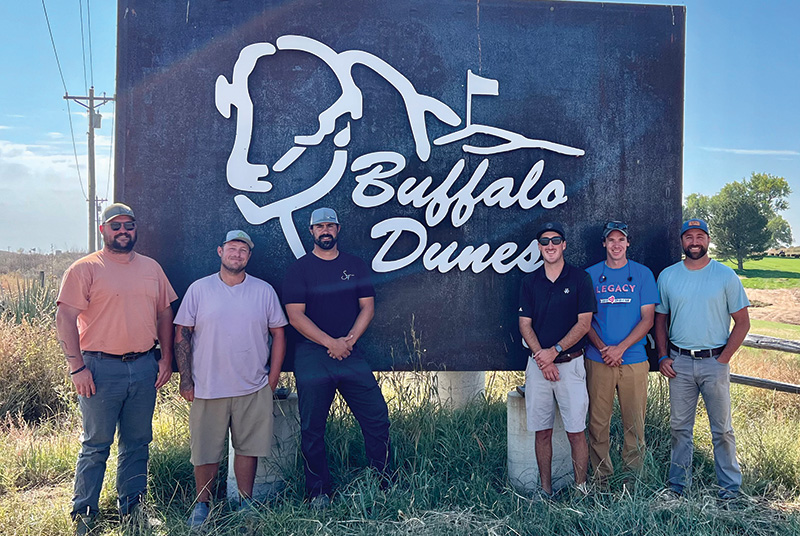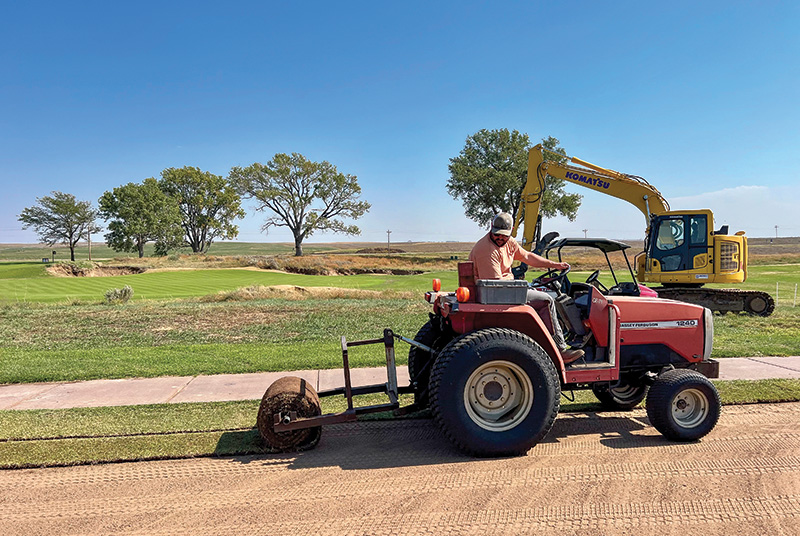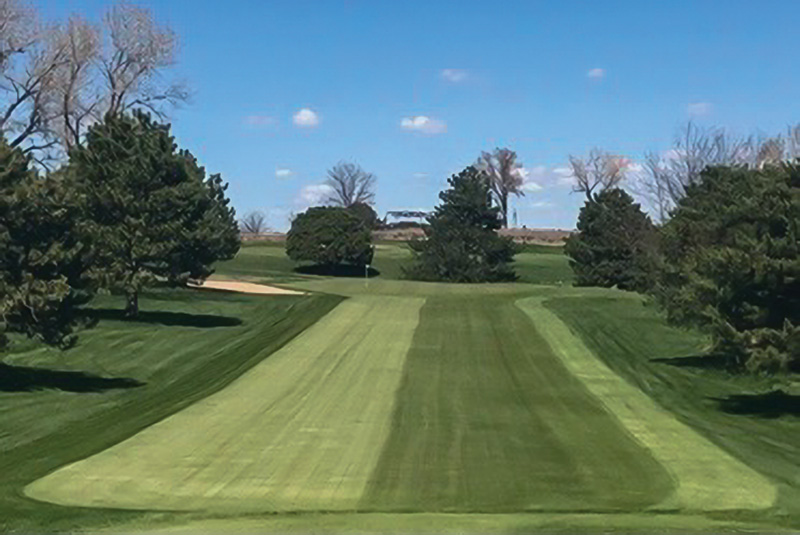
Turnout for one of the city employee work days during the course’s six-year renovation. Photos courtesy of Clay Payne
Clay Payne would be the first to admit the audacious renovation of Buffalo Dunes Golf Course wouldn’t be possible just anywhere.
For one thing, Buffalo Dunes GC, where Payne has served as GCSAA Class A superintendent since 2017, is built on a natural dune site outside Garden City, Kan. Drainage is not an issue.
The irrigation system might not have all the bells and whistles, but at around 10 years old, it doesn’t need replacing.
The esteemed municipal course already had its agronomy dialed by the three superintendents who preceded Payne over its almost-50-year lifetime.
And Payne, an 11-year GCSAA member, is blessed with a core of three thirtysomething assistant superintendents who, critically, are locals who came to appreciate the course long before they began working there.
So, yes, Buffalo Dunes had some advantages other courses might not, but Payne is convinced the model by which Buffalo Dunes — already a spectacle in its own right — is turning things up a notch can be imitated elsewhere, and to the same effect.
“It won’t be easily replicated, but hopefully some of it can be,” Payne says. “For a small staff, it was a pill we could swallow. We can do the little stuff, and enough little stuff becomes big.”
While a renovation of this scope easily could run well into the seven- or even eight-figure range, Buffalo Dunes is getting its gorgeous glow-up for a fraction of that. Originally projected to cost around $800,000, the project — and it’s an extensive one, including 18 new greens with modern bentgrass, four “blown-up” holes, naturalized bunkers, removal of nearly 200 trees and drastic reduction in irrigated turf — should wrap up next fall with an all-in price tag of right around $400,000.
In Payne’s mind, though, the renovation at Buffalo Dunes isn’t so much about how so few did so much with so little but how so many from so close — golfers and nongolfers alike — came together to make it happen.
“It’s not about the dollar amount. It’s the relationships, the bonds that were created from this,” Payne says. “It’s not Buffalo Dunes. It’s the city of Garden City, and they’re all proud of it.”

Part of the Buffalo Dunes Golf Course’s renovation entailed replacing an old “dirty” mix of Penncross bentgrass putting surfaces with more drought- and disease-resistant Dominant X-Treme 7 bentgrass.
‘Sacred ground’
After graduating from Kansas State University, Payne, a native of nearby Cimmaron, Kan., spent time as an assistant superintendent then course superintendent at Dismal River Club in Mullen, Neb., and then assistant superintendent at Ballyneal Golf Club in Holyoke, Colo., both of which are built atop similarly sandy sites, before leaving for Buffalo Dunes seven years ago.
The funny thing about Buffalo Dunes’ renovation is that it didn’t necessarily need one. Sure, the Frank Hummel design that in 2021 was named the No. 8 municipal golf course in the country by Golf Magazine could have stood to lose many of the 30-year-old pine trees that narrowed the fairways and clogged the views, and maybe the greens and bunkers could use a touchup. What nearly 50-year-old course couldn’t?
Payne’s first task was to convince the folks at the City of Garden City — which was gifted the land in 1974 by local businessman Earl Brookover, on the condition that it be turned into a golf course — of the need to fix something that wasn’t especially broken.
“Buffalo Dunes is a very respected facility, very highly regarded,” Payne says. “It’s sacred ground.”
The city eventually came around.
“We have 100% support from the city,” Payne says. “As we were trying to sell the project, we learned one commissioner was very into environmental sustainability. Well, here’s why this project makes sense. Oh, you golf? Well, we’ll have the best greens in the area.”
A key part of the renovation was Payne’s suggestion to fund a master plan. The city had recently approved the salary for an assistant superintendent, but that assistant — Mitch Chalkley, another Cimarron native — was still finishing up his coursework at Kansas State. Payne suggested that salary that year go to a master plan instead, and the city reluctantly agreed.
With Chalkley, a 10-year GCSAA member, in the fold the following year, the master plan was set in motion. Todd Clark and Zach Varty were hired as architects. In a nod to the small staff — Payne, Chakley, fellow assistant superintendents Bryer Livermore and Brock Walter and mechanic Mike Mathias are the only full-time employees, supplemented by three or four seasonal employees — the decision was made to tackle the renovation in phases. The six-year plan called for dealing with three greens per year. A sod nursery was expanded to an acre — just the right size to grow enough sod starting in the spring for resodding on the three greens in the fall.
Then, in the fall of 2020, with the world still grappling with the coronavirus pandemic, Buffalo Dunes crew members rolled up their sleeves and set to work.

The bulk of the renovation work at Buffalo Dunes was performed by, from left, seasonal employee Heath Kirmer; assistants Bryer Livermore, Brock Walter and Mitch Chalkley; shaper Zach Varty; and superintendent Clay Payne.
Community involvement
It didn’t take long to realize the small crew would need some help, and Payne knew just where to solicit it.
As a kid growing up in Cimarron, Payne started out playing the community nine. In 2000, that course replaced its original sand greens with grass, and though the shaping was hired out, community members turned out to provide much of the labor.
“It was cool to see that at an early age,” Payne says.
He was convinced Garden Citians would turn out, too. Payne organized three outside workdays per phase. Two weekday workdays were for city employees, who received credit for time worked. The third was open to the community.
Each workday for each of the first four phases drew anywhere from 15 to as many as 40 workers. City firefighters turned out in full garb in case they were called away for an emergency. The police chief worked a shift. An octogenarian judge reported to work unaware the task was to be laying sod on a green and its surrounds; he made a trip to the pro shop and returned with two new golf gloves — one right, one left — and laid sod for hours. In all, 20 city departments were represented. High school teams turned out on community days.
And a funny thing happened.
“That first hole took us four days. We thought we could do it ourselves,” Payne says. “Now we can do it in 3½ hours to lay a green and collar. And they’re invested in it. Even if they’re not golfers, there’s pride that, ‘This is my green.’”
Though the original plan was to complete three holes per year, the crew was able to pick up an extra hole here and there and rolled into the fifth phase this past summer with four holes remaining, a full phase ahead of schedule. Because the last four holes were the most complex and required extensive irrigation work, the greens were to be grown-in from seed.
“People were legitimately mad when we got to this year. ‘You’re seeding them all? You don’t need to lay sod this year?’” Payne recalls with a laugh. “They were mad they couldn’t help this year.”
The community angle wasn’t one-sided. Rather than kill off the predominately Kentucky bluegrass areas that were replaced with natives (of the site’s 320 acres, the renovation will take irrigated acres down to 85, with a goal to get down to 60), the crew cut it out as sod, which was then donated to other city facilities, like the zoo and pool.
And the old bentgrass greens — which Payne describes as a “dirty” mix of Penncross — which were replaced by more drought- and disease-resistant Dominant X-Treme 7 were again cut out as sod and offered to area golf courses.
“All these regional nine-hole courses came and are using our old bentgrass,” Payne says, adding a course in Texas also benefited by his bentgrass largess. “It’s cool to be building this whole community from this.”

Rolling sod on a new tee. Payne says the staff-made three-point sod rolling attachment was a “game changer.”
Understanding the why
The first four phases typically ran from just after Labor Day until Halloween, as the golf started to cool off for the year, allowing the full-time staff to devote most of its time to the renovation and leaving the day-to-day upkeep to the season staffers. A fleet of 14 autonomous rough mowers helped to that end.
This year’s more complicated phase started just after the Fourth of July.
Throughout, the course kept a minimum of 15 holes open every phase, with temporary greens as needed so golfers could get “all their swings in.”
As the years went on, the team learned efficiencies.
“Most of us became more confident every year,” says Walter, a one-year GCSAA member. “Every year, it seemed to get easier. We seemed to perfect it almost.”
The team perfected the scoop-and-dump approach to naturalizing the bunkers: Using a mini excavator, a worker would grab a scoop of native fescue, then dump it in the bunker face. “It immediately looked like it had been there for years,” Payne says.
The Buffalo Dunes crew also perfected sod transfer. At first, the team — and community — members tediously picked up small pieces of sod to be relaid. Mathias fashioned a way to pick up 20-yard rolls with a tractor’s three-point attachment. “It was still hard work,” Payne says, “but it was faster, and there were fewer seams.”
The renovation still has a summer to go, just “picking off little things,” Payne says. “But we’re looking forward to not having anything to do for a while.”
Though Buffalo Dunes didn’t necessarily need to be remade, folks have already begun to take notice. Back in 2017, the course saw 14,500 rounds. There were 20,000 rounds already by Oct. 1 this year, trending toward 22,000 to 23,000.
Last month, Payne was headed to the parking lot and saw some unfamiliar faces. He stopped by to chat them up and learned it was a group of golfers from Texas, on their way home from a golf trip to Wild Horse Golf Club in Gothenburg, Neb. They didn’t have time for a round but made a special trip to visit, if only for a few swings on the chipping area.
“They had heard about us,” Payne says, “and just wanted to come see it.”
Though the renovation took its toll on the staff — “We are concerned, every year we’ve lost 10, 15 pounds because of this. Not doing this is going to be hard to get in shape before winter,” Payne says with a laugh — one of its goals was to make their work ultimately easier.
Sustainability was a big part of it. Money saved on fungicides for the new turf more than offset the cost of the sod nursery, and the turf reduction should save 12-20 million gallons of water a year. Eliminating two of the three man-made ponds on-site should save a handful of labor hours previously committed to tumbleweed removal.
“They understand the why,” Payne says of his crew members. “They all love golf. They all have babies. You don’t have to talk them into doing anything. Sure, there were some pep talks, but you didn’t have to talk them into doing it again. It’s a legacy thing. It’s not my project. It’s not a Buffalo Dunes project. It’s a Garden City project, a regional project, and they’re a huge part of it. Once we’re done, it will be so much easier to take care of, and we can go home and be good husbands and fathers.”

A look down Buffalo Dunes’ No. 17 hole before (top) and after the renovation.
‘It’s a different course’
Even the time spent in renovation season wasn’t overwhelming.
“In our industry, there are a lot of people working 60-, 70-, 80-hour weeks,” Chalkley says. “It’s not the easiest job. I’ve worked where you’re working 4:30 in the morning until 10 p.m. The way we’re doing it, I’m still able to go home and be a dad. It’s a breeze compared to the industry in general.”
To a man, the team is eager to play the course once it’s redone. Payne says in addition to the assistants’ local ties — Chalkley is from Cimarron, Walter is from nearby Sublette and Livermore from Garden City — they also share a love of the game of golf.
“Finding local talent is everything,” Payne says. “It’s that pride factor. They grew up playing this course, and there’s a lot of pride doing this for their kids. And this is the best golfing staff … I’d put them up against anybody.”
“I can’t wait to go play it,” adds Livermore, who joined the staff not long after attending a sod-laying employee day when he was working at the Garden City zoo. “After growing up with this course and seeing the renovation form the first year to now, I’m excited. It’s a different course than when I grew up.”
Varty, the shaper (and son of a Minnesota golf course superintendent) who visits for renovation season and stays with Payne’s family to save money, has been part of more traditional renovations. He’s convinced the Buffalo Dunes approach can be imitated elsewhere.
“It’s a model that can be replicated at thousands of other courses,” he says.
But should it be? If five years ago Payne were handed a fat wallet and told to outsource a more traditional renovation, would he?
“If we’d had the cash, sure, I would have preferred not to put that strain on my staff to do all the labor, but we weren’t dealt that hand here,” he says. “I think a lot of courses wait for that cash, then all of a sudden, it’s 10 years later. I don’t think this is an anomaly. I mean, I’ve seen it twice now — both times within a few miles of each other — but I don’t think this is a western Kansas thing. It’s a community thing. I’m proud of what we’re doing.”
Andrew Hartsock is GCM’s editor-in-chief.